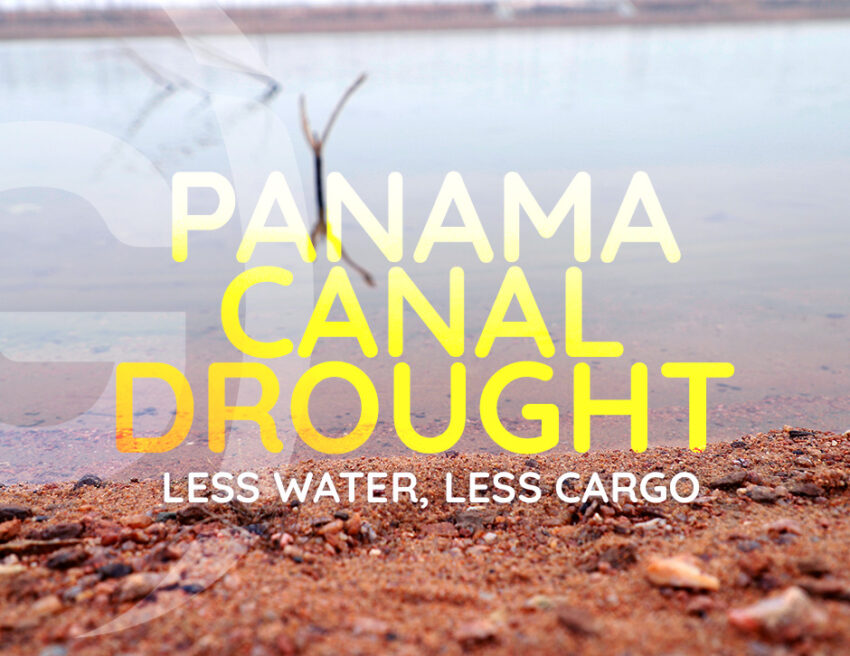Climate change is affecting the viability of the Panama Canal, a crucial artery for global trade. A prolonged and severe drought during what should have been Panama’s rainy season has significantly lowered the water level of Gatún Lake, the freshwater source essential for operating the canal’s locks. The lake is currently nearly 6 feet below its level a year ago. This decline has resulted in congestion in the canal, which handles approximately 5 percent of worldwide ocean freight shipping, including almost half of the containers transported from Northeast Asian ports to the eastern United States. In this blog, we are going to update you about the ongoing drought situation in Panama Canal and how it is impacting the global ocean freight shipping sector.
What’s happening in the Panama Canal in 2024?
A lengthy queue of idle vessels now stretch at both ends of the canal. Despite recent rainfall providing some relief and enabling a partial recovery from the sharp decline that commenced in autumn, the daily transit rate stands at 24 ships, still significantly lower than the pre-drought average of approximately 36. The volume of cargo moving through the canal experienced a notable decrease which is compelling shippers to explore alternative routes, causing disruptions in supply chains, particularly in sectors like agriculture and energy.
Panama Canal Administrator Ricaurte Vasquez reported a notable decline in cargo and ship traffic through the passageway during the first quarter of the fiscal year, with a 20% reduction in cargo and 791 fewer ships compared to the corresponding period the previous year. Characterizing this decrease as a “significant reduction” for the country, Vasquez acknowledged the challenges. Despite the setbacks, Vasquez highlighted that improved water management practices and a substantial increase in rainfall during November have allowed them to maintain water levels at a sufficient height. As a result, they can facilitate the passage of 24 ships daily until the end of April, marking the commencement of the next rainy season. This temporary measure is seen as a step towards mitigating the impact of the ongoing challenges faced by the Panama Canal.

What the authorities are doing to counter the problem
The current projections from canal administrators suggest that the decline in water levels may result in a financial impact ranging from $500 million to $700 million in 2024. This estimate represents a significant increase from earlier assessments, which had anticipated costs of around $200 million. The heightened financial implications underscore the severity of the challenges posed by the diminishing water levels in the Panama Canal and highlight the need for effective strategies to address the evolving situation.
The Panamanian government is urgently working to devise a solution to salvage the canal, which plays a pivotal role in the country’s economy by generating over $3.3 billion in tolls. The urgency stems from the significant contribution the canal makes to the nation’s economic stability.
The Panama Canal finds itself in a particularly precarious situation, as its operation relies heavily on substantial amounts of freshwater to operate the locks facilitating the passage of ships between the Atlantic and the Pacific. Unfortunately, a considerable portion of this water becomes too saline, as it gets mixed with seawater during the process, rendering it unsuitable for agricultural or human use.
In the short term, a temporary solution involves releasing water from Lake Alajuela into the canal. Additionally, one significant proposal involves a multibillion-dollar initiative to construct a dam on the Indio River, creating a reservoir. This reservoir would serve as a source for pumping freshwater through a mountain into Lake Gatún, aiming to sustain adequate water levels. In exploring unconventional solutions, another idea on the table involves cloud seeding to stimulate rainfall, addressing the water scarcity issue.
How the ocean freight shipping industry is dealing with the crisis
Certain companies had considered rerouting their shipments through the Red Sea, a critical route connecting Asia and Europe, as a strategy to evade the increasing delays at the Panama Canal, according to analysts. However, these plans have been disrupted by Houthi attacks in the region and the subsequent military responses from Western nations. The heightened security concerns and geopolitical instability in the Red Sea area have forced companies to reassess their contingency plans, as the originally envisioned alternative route is now fraught with challenges and risks.
Maersk recently announced its decision to utilize trains on the Panama Canal Railway, situated alongside the canal, as an alternative route, completely circumventing the waterway. This strategic shift is prompted by the need to navigate the challenges posed by the canal’s operational constraints due to drought-related draft restrictions. Previously, Maersk and other companies had been utilizing the railway to temporarily unload container weight from large ships before proceeding through the canal. Now, with the decision to entirely bypass the waterway, Maersk acknowledges that this rerouting may introduce some delays for southbound vessels.
Maersk’s client advisory highlighted that due to the existing and anticipated water levels in Gatun Lake, the Panama Canal Authority (ACP) has implemented necessary reductions in the size and weight of vessels permitted to traverse the canal. In response, Maersk is actively collaborating with the ACP to adapt its operations and align them with the evolving conditions.


